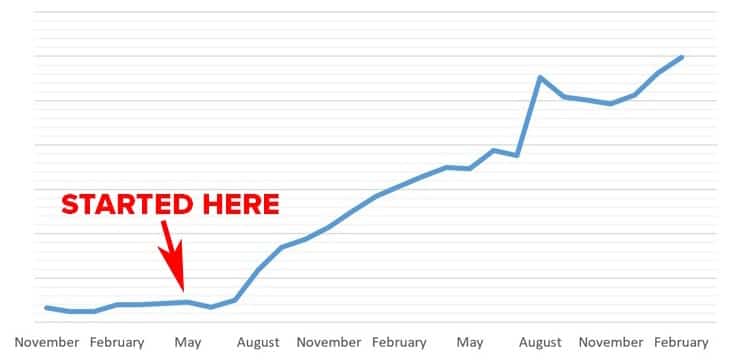B2B Content Marketing: A Practical Guide
by Aden Andrus • July 5, 2018
Marketing a B2B business is hard. Your market is usually fairly niche, which means you’re often competing with a lot of other businesses for a fairly small target market. To make things even worse, your sale cycle is usually fairly long and involved.
High competition, niche target market and long sales cycle? It’s a marketing nightmare!
To succeed at B2B marketing, you need a marketing strategy that delivers cheap clicks, helps you build your brand with a small target audience and provides value across your entire sales cycle. Plus, it wouldn’t hurt if that strategy gave all of your other marketing efforts a boost, too.
In my experience, there’s only one strategy that meets all of those criteria: B2B content marketing.
I won’t lie to you, putting together an effective B2B content marketing funnel isn’t quick or easy. It takes a lot of work and refinement, but the results are definitely worth it.
Does B2B Content Marketing Work?
When I first started working at Disruptive Advertising, our marketing was completely dependent on paid advertising. As a B2B marketing agency specializing in paid search management, that made sense. However, it was an expensive way to grow our business.
So, we started investing heavily in content marketing. We began blogging consistently, created a variety of marketing assets, built out email marketing funnels, redesigned our website—we did everything right.
And then…nothing happened.
Well, not exactly nothing. We started getting more traffic and more leads, but we really didn’t see an increase in sales. It was months before we even started to see any real results.

As you can see, it took a year or two of effort before our B2B content marketing really started to pay off. It was a long, hard and stressful, but after a couple of years of effort, content became our dominant source of traffic, leads and sales.
Today, our content marketing produces 130x more new revenue each month than it did when we started. Every month, content marketing generates more money in new sales than we invest into content. In B2B, where you usually measure the ROI of your marketing against the lifetime value of a client, having a marketing channel that is profitable from day one is a big deal.
Disruptive Advertising wouldn’t be the company it is today without content marketing.
And we’re not the only company with this kind of story. When done right, content marketing costs 62% less than traditional marketing and generates 3x as many leads per dollar spent.
The only problem is, if you’re looking for a quick and easy way to increase revenue today, content isn’t the answer. To really get results from B2B content marketing, you need to be committed for the long haul. It will take a lot of blood, sweat and tears, but ultimately, it will be worth it. B2B content marketing is the most effective way to grow a B2B business.
How to Do B2B Content Marketing Right
Effective B2B content marketing isn’t a matter of writing a 200-word blog post a few times a week or posting the intermittent PR piece. If that’s all content marketing is to you, you’re better off investing that time into some other marketing channel.
Effective B2B content marketing operates off the same principle that has made non-commercial content machines like the Art of Manliness or the Huffington Post so successful: They build an audience.
Unlike most marketing content, building an audience isn’t about selling your product or services. It’s about giving people something that they value.
Maybe you have special information that helps your audience. Maybe you discuss concepts in an entertaining way. Maybe you make them feel good or powerful or like they are part of something meaningful.
Regardless of the specifics, great B2B content marketing gives people something that they value. And, in return, that value convinces them that you are a business they want to, well, do business with.
With all that in mind, here are a few ways to improve the quality and performance of your B2B content marketing:
1. Stop talking about yourself!
Most B2B content reads like an informational brochure. They take every possible opportunity to mention their business and how great it is.
Unfortunately, to your readers, that’s the content marketing equivalent of Miss Othmar…
Guess what? No one checks out your content because they want to hear about your business. If people want to read about your company, they’ll click on an ad.
People read your content because they want value. Often, it’s because they believe that you have information they need. If they get a brochure about your business instead, they’re going to feel frustrated.
Of course, that doesn’t mean you can’t mention your business or the awesome things you do for your customers. You just need to be more subtle about it.
That being said, people are okay with you talking about yourself…as long as it feels like a natural part of your article. They get it. You’re a business and you draw on your experience as a business to create your content.
So, if you are writing a case study, you can reference yourself. After all, you’re part of the story. Just don’t go on and on about how awesome you are—let your reader come to that conclusion on their own.
When it comes to B2B content marketing, focus on delivering value, let people sell themselves on your company and then give them a way to buy—don’t use your content to sell yourself.
2. Write Something Worth Reading
Contrary to popular belief, you don’t have to write 4,000 words to have a decent content marketing piece. However, if your content is only 200 words long, your audience may come away feeling like you don’t really understand your topic or you don’t have anything meaningful to say.
When it comes to content marketing, quality is better than quantity (although a quantity of quality is ideal). If you have 5 tips to share, don’t split them up. Put them all in one article—even if that means you don’t get 5 articles out this week.
On the other hand, don’t write more words just to boost your word count. People can spot empty content a mile away. After all, anyone who’s ever written a high school paper with a minimum word count has included filler content before.
And…

I could go on, but then this would start to feel like filler content, so let’s wrap things up, shall we?
In general, I’d recommend an absolute minimum of 500 words for a blog article, if not 700-1000+, depending on what your audience responds to. After all, if you don’t have at least 500 words to write about a topic, does that topic really deserve to be an entire blog post? Other types of content should have enough words to adequately cover the topic without getting lost in the details.
3. Write Something Worth Sharing
Sharing is the lifeblood of content marketing—even B2B content marketing. If your content isn’t being shared, you aren’t building an audience.
According to the New York Times Customer Insight Group, there are 5 key reasons why people share content on social media:
- To provide others with valuable and entertaining content
- To define themselves
- To develop their relationships
- To feel more involved in the world
- To support issues or causes they feel passionately about
If you aren’t creating content that people will share for one of these reasons, odds are that it won’t get shared.
Now, not all shares happen via social media. Sometimes people share via email/text or simply show an article to someone (even a printed version of an article, heaven forbid!). However, how your content is shared is less important than the fact that it is being shared.
Remember, your goal is to build an audience. The more people who see your content, the bigger your audience will be.
With all that in mind, you need to create content that people will want to share. If you can write in an entertaining, engaging style—do it! If you can write material that helps people understand themselves and the world better—do it! If you can write stirring stories about important issues—do it!
Depending on what you’re good at, you can be cheeky, deeply insightful, enthusiastic, a great storyteller…the list goes on and on, but the important thing is, write something that you would look forward to reading.
If you don’t enjoy writing it, your audience won’t enjoy reading it. And, if they don’t enjoy reading it, do you think they’re going to share it?
4. Understand Your Business Goals
While it is important to write a meaningful, shareable content, its also important to remember that you can’t just write articles about celebrities or cat videos. Your content needs to achieve a business goal.
For example, if your business goal is to build upper-funnel brand awareness, you might write articles about broad topics your audience cares about. This is especially effective if you do a little paid promotion on social media to get more eyeballs on your content.
On the other hand, if your business goal is to resolve bottom-of-the-funnel concerns so that a CEO or decision-maker will feel comfortable signing a deal with your business, you might write about specific experiences or results your customers have had that relate to the concerns you are trying to address.
Can you see the difference here? Depending on your business goal, what you write about (and how you write about it) will change. This sort of audience awareness is at the heart of any good B2B content marketing strategy.
5. Nail the Details
When it comes to B2B content, details matter. Nothing says, “this is my obligatory blog post for the week” like a poorly written article.
In particular, while you might not be a grammar Nazi, nothing undercuts your blog’s credibility like sloppy writing—59% of people wouldn’t buy from a website with poor grammar!

In all seriousness, though, if you don’t care enough about your content to make it clean and easy to read, your audience won’t care enough to read them. The same idea applies to eBooks, infographics, images and video content.
In addition to creating clean content, it’s important to pay attention to your tone and voice. You’re building an audience, so you need a consistent tone and voice that works for your audience.
In choosing the tone and voice of your B2B content marketing, I generally recommend sticking with a conversational tone. Many B2B businesses think that they need to be stiff, formal and professional to be taken seriously, but remember, the goal of your content is to build an audience, not create technical documentation or a glossary of terms.
People want to feel connected to other people. That’s just as true for the CEO of a billion-dollar company as it is for a high-school cheerleader. People want to hear thoughts, feelings and insights. If they just wanted information, they’d read an article on Wikipedia.
With all that in mind, the easiest way to catch both grammar and tone problems is to read your content out loud to someone (if you don’t have someone handy, this online tool is another good way to check your post).
If you can’t read it out loud without stumbling over words or gasping for breath at the end of a sentence, you’ve got a grammar problem. If your listener’s eyes glaze over or they get distracted while you’re reading to them, your content needs to be more interesting.
Turning Your Content into Leads and Sales
So far, everything we’ve talked about applies to building an audience with your content. This is great for getting people to read your content and visit your website. If your content is good enough, you’ll even get some leads and sales out of it.
But, if you really want to make the most of your B2B content marketing, you need to do more than create engaging content. You need to create a content marketing funnel that convinces your audience to convert and buy from your business.
Here are a few strategies you can use to get more leads and sales out of your content marketing.
Let’s take a look at 7 strategies you can try to get more content marketing leads:
1. Content Upgrades
Blog posts are an essential aspect of any content strategy. They drive awareness of your brand, give search engines more opportunities to display your site and they establish your business as competent and knowledgable.
But, without lead magnets, blog posts don’t drive a lot of leads.
A simple way to add lead magnets to your blog posts is to offer content upgrades. These are boxes in the middle of posts that offer further information about a topic in exchange for a user’s contact information. Content upgrades can lead readers to any type of gated or premium content.
2. Gated/Premium Content
As mentioned above, offering gated and/or premium content—eBooks, white papers, study data, recorded podcasts, etc—is a great way to encourage people to move deeper into your content marketing funnel. They offer permanent value in the form of in-depth information that will benefit your users.
To make things even better, when someone hands over their personal information in exchange for your lead magnet, it’s a sign of trust. Essentially, when someone accesses your gated content, they’re telling you “I’m really interested in what you have to say.” That frees you up to be a bit more promotional with your content.
You still need to be careful about being overly promotional in your premium content, but now you can get away with adding a quick, subtle pitch and a call to action at the end of an eBook or a webinar encouraging people to use your business. Most people won’t take you up on it, but a few will and it’ll get the rest thinking about using your business.
3. Host a Webinar
A live webinar is like premium content on steroids. Why? People love the experience of being at a live event. It’s why people still attend sports games and concerts—even when the viewing and listening experience is better at home.
Most people who attend your webinars will never directly engage with you. But, simply knowing that they can talk to you makes attending a live webinar that much more compelling.
In addition, hosting a webinar helps you build an even stronger relationship with anyone who attends. You become more than just a piece of content. You become a human that your potential customers trust. As a result, they are a lot more likely to remember you and reach out afterwards—especially if you send an after-webinar email thanking them for attending.
To make sure that your webinar maintains that “premium” feel, your webinar should provide useful advice or information that is unavailable elsewhere. In the description of your webinar, summarize what you’ll be covering in a way that is tantalizing but avoids giving away too much.
4. Offer Interactive Content
Another way to move people down your B2B content marketing funnel is by offering an interactive tool. Interactive tools allow you to personalize the experience for your audience and differentiate your brand from the competition.
There are many possibilities for interactive tools, but calculators and quizzes are excellent options. Like premium content, you can require users to provide you with their email addresses before they can see their results, which gives you more ways to stay in front of them through your marketing and sales cycle.
The biggest advantage to interactive content, however, is that it teaches you about the people in your funnel.
If you set it up right, you can create interactive content that encourages your potential customers to self-identify their interests and concerns. This is invaluable information that you can use to customize your lead nurturing efforts and help lead people further down your funnel.
Conclusion
B2B content marketing is one of the best long-term investments you can make in your business. It’s not a quick and easy way to get more sales, but it will eventually become your biggest and most profitable source of new revenue.
The trick is figuring out how to build an audience and nurture them through your content marketing funnel. It will take some trial and error to get right, but trust me, the results are worth it.
By the way, if you have any questions about B2B content marketing, leave them in the comments. I’d love to help you create a strategy that will pay dividends for years to come.
How do you approach B2B content marketing? Any recommendations you’d add to this article? Leave your thoughts in the comments below!





